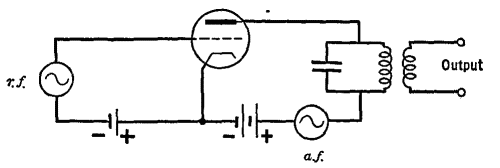| Basic Radio is a free introductory textbook on electronics based on tubes. See the editorial for more information.... |

|

Home  Transmission of Signals Transmission of Signals  The Principle of Amplitude Modulation The Principle of Amplitude Modulation  Plate Modulation Plate Modulation |
|||||||
| See also: A Crude Method of Amplitude Modulation, Grid-Bias Modulation, Suppressor-Grid Modulation, Cathode Modulation | |||||||






|
|||||||
|
Plate ModulationAuthor: J.B. Hoag Today, the most widely used method for amplitude modulation is known as plate modulation. In this system, radio-frequency or "driver" voltages are applied to the grid of an amplifier (called the "modulated" tube). The audio-frequency or "modulation" voltages are inserted into its plate circuit in series with the B-power supply, as in Fig. 16 F.
In order that the a.f. in the plate circuit shall be sufficiently strong, it is necessary to strengthen the microphone voltages with a speech amplifier. The last stage in this amplifier is called the modulator. The secondary of the audio transformer in the plate circuit of the modulator is in series with the B supply of the modulated tube, as in Fig. 16 G.
The radio-frequency-choke coil, r.f.c, keeps the high frequency from shunting through the grid-bias battery, and the bypass condenser C keeps it out of the B-battery and speech amplifier.
In Fig. 16 H, we see that when, during a positive half-cycle of the audio frequency, the plate voltage is increased above that of the B supply, the plate current likewise increases. Similarly, when the a.f. is in opposition to the steady B voltage, the output decreases. In order that the rise and fall of the amplitude of the output r.f. shall be a faithful copy of the a.f., the driver's voltage must be large, and the C-bias, the B voltage, and the circuit constants must be properly chosen. In order that the changes in the amplitude of the carrier wave shall be large, the output voltage of the modulator must be nearly equal to that of the B supply.
|
|||||||
Home  Transmission of Signals Transmission of Signals  The Principle of Amplitude Modulation The Principle of Amplitude Modulation  Plate Modulation Plate Modulation |
|||||||
Last Update: 2009-11-01




